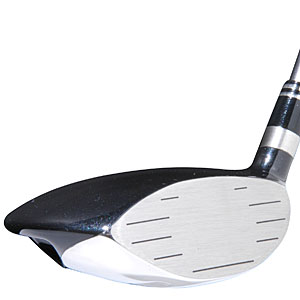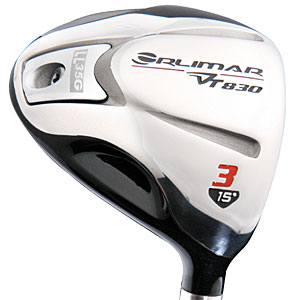![]() Orlimar at one point was one of the big players in the fairway metal wood market. At courses around the world you could find their clubs in the bags of players of all handicap- and skill levels. Just like everyone else, I hit a few different Orlimar clubs when they were hot.
Orlimar at one point was one of the big players in the fairway metal wood market. At courses around the world you could find their clubs in the bags of players of all handicap- and skill levels. Just like everyone else, I hit a few different Orlimar clubs when they were hot.
Since the Tri-metal line was introduced in the late 90s, Orlimar has not enjoyed much success. The struggling company has introduced the VT830 to help recapture that success and hopefully get themselves back into the game.
Build
 Orlimar has exclusive use of Alpha 300 steel for the build of their new fairway wood. Its shaft is a half inch longer than the standard 3-wood… at least the Callaway Steelhead Plus I’ve been using for the past 4 years. The VT830 has a very simple design from the top of the club. On the bottom is where the construction takes a much more different and complicated turn.
Orlimar has exclusive use of Alpha 300 steel for the build of their new fairway wood. Its shaft is a half inch longer than the standard 3-wood… at least the Callaway Steelhead Plus I’ve been using for the past 4 years. The VT830 has a very simple design from the top of the club. On the bottom is where the construction takes a much more different and complicated turn.
In the past year or so, the replacement weight have burst on the scene. These are seen most commonly in the TaylorMade R7 Quad driver. Orlimar, late to the game but once the hit of the party, has incorporated (re)movable weights into the VT830, making it one of the first fairway metals available with replacement weights. TaylorMade’s own r7 line of fairway woods is, naturally, the other.
Where the TaylorMade drivers and most other clubs weights allow people to adjust weight and launch left and right, the Orlimar VT830 lets you adjust the club for low and high trajectories. The two weights are called “LL35G” for low trajectory shots and “HL35G” for high trajectory, and only one can exist in the club at any given time. Each weighs 35 grams (hence “35G” in the name), and Orlimar provides a wrench to remove and install the weights.
The other feature that the VT830 has is a CoR (Coefficient of Restitution) of 0.83 which is the maximum CoR allowed by the USGA. The CoR, also known as the “spring effect,” is monitored closely by the USGA. The Orlimar VT830’s CoR gives it some kick off the clubface and produces distance that may not be expected.
Look and Feel
The VT830 has a sleek look to it. The face of the club is small and takes on an oval shape with the bottom and top being rounded; more so than other fairway metals such as the Titleist 904F which has a flatter sole and a much straighter top to the face. Personally, I’m a fan of the rounded bottom as my trusty Callaway Steelhead plus also has the same feature. When grounding the VT830, you can feel the leading edge flush with the ground and can tell that hitting off of tight fairways or thin lies are not a problem. This was a big plus to me when I first started examining the club.
The VT830 feels very light in the head. As soon as you pick it up, you can tell that the bulk of the weight is located in the shaft of the club. The shaft is 75 grams, a healthy weight that contributes to the poor weight distribution. To some people this may be a welcome feel, but I am one who likes a fairway metal wood to have a heavier head. One thing is for sure: the Orlimar VT830 may appeal to those looking to generate a lot of clubhead speed.
 One strange thing to me was how hollow the clubhead felt. After hitting a ball and tapping the next one towards me, the sound and feel generated by the clubhead made me very aware of the fact that I was playing with a hollow metal box on a stick, essentially. This, combined with the light feel of the clubhead, did not inspire confidence in the VT830. This was one of the first woods I have ever hit that it almost felt like the head was going to cave in after striking the ball.
One strange thing to me was how hollow the clubhead felt. After hitting a ball and tapping the next one towards me, the sound and feel generated by the clubhead made me very aware of the fact that I was playing with a hollow metal box on a stick, essentially. This, combined with the light feel of the clubhead, did not inspire confidence in the VT830. This was one of the first woods I have ever hit that it almost felt like the head was going to cave in after striking the ball.
Performance
I will say that the club was very hot. They talk about the CoR and rave about the exclusive access to Alpha 300 steel. It is very true – the ball absolutely jumped of the clubface. One thing I wish I could have measured was the speed of the ball coming off of the face of the VT830 compared to my old Callaway Steelhead Plus.
One problem with the “hotness” was that the ball had too much spin. When a shot started left, it kept going that way… and if you cut it a bit, yup, it really went right. I swapped my 3-wood and the Orlimar back and forth and my club did not stray nearly as much as the VT830. The extra spin also generated a few balloons into a slight breeze, which negated the extra distance the hot face and lighter clubhead provided. Personally, I’m looking for consistency with my fairway metals and something I can rely on hitting straight. I didn’t seem to get that with the Orlimar. It was simply too hot and produced too much spin for my liking.
After hitting a bunch of balls off the deck, I started teeing the ball up. I hit some really nice shots, as I rely on my current fairway metal off the tee quite a bit. The Orlimar did just as good as and sometimes better than mine. The times that I hit the VT830 good, it was very long off the tee and had a great ball flight. The times that were not so good, it had the same wild spin off the club face I experienced off the ground. I could control the ball a little better off the tee with the VT830 than off the ground, but not much.
As for the replaceable weights, I really didn’t notice too much of a difference when I switched from the low trajectory to the high trajectory. When I switched in the HL35G it didn’t seem to fit as well as the LL35G. I tried a few different times but didn’t have success. This might explain the lack of any noticeable change in ball flight. Regardless, don’t expect to see low, boring shots with the LL35G and then high, soft ones with the HL35G – they just don’t act that differently.
When it’s all boiled down, I simply didn’t care for this club’s performance. I really prefer to have the weight of my fairway metals in the head of the club, and the VT830 felt way too light in the head almost to the point that I could not control the takeaway of the club. That’s not a good way to start the swing. I didn’t feel that the high CoR really gave me as much of an advantage as it does in drivers. If a club can be too hot, well, the VT830 is that club.
Conclusion
Orilmar has had past success in this area with their Tri-metal woods but have since slipped back into the role of a niche player. Orlimar has incorporated some newer design features, but I the VT830 is not the club that will bring Orlimar back to life.
The VT830 is a hot club. Too hot. The trend of woods in the recent years is to take spin off of the club and this seems to do just the opposite. If you are looking for a consistent club out of the fairway or rough, the VT830 is not the club for you. If you need a little extra distance and need a good backup to your driver, then you may want to consider this club. Hit a demo on the range to see if it suits you though.
As for me, I’m sticking with my 5-year-old fairway metal.

I purchased the 3 and 5 wood vt830 and have been somewhat surprised with the action. I hit the 3 extreamly well off the tee, when the driver is too much. I, too have had some control problems with the club off the fairway…like you said once it starts spinning there is no brining it back. I seem to hit the 3 a lot better than the 5 for some reason. Decent set though, when I do hit it right is goes and goes.
I got the vt830 3 wood because my 3-wood had to big of a face. I hit this three wood especially well off the tee. I seem to hit a draw with this club off of the fairways and the rough. Very nice club, even though if I hit it so-so off of the fairway. I would get this club if I were you.
I bought this club and I do not agree with the review I have found this club to be very nice to hit and a very soild club I don’t know how he thinks it is hollow box (wrong) try this club before you listen to this review. I think he is used to his old one and thats great
I’ve owned alot of different fairway woods, but the vt830 fairway woods are by far the longest…I would also disagree with the control problems on and off the tee. Sounds like Dave Koster needs his shafts pured maybe?!?! Come on dave get with the program!!! But yeah, Im a 7 handicap and i’m sticking with these bad boys. (9 out of 10 club performence rating)